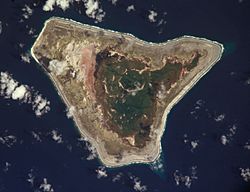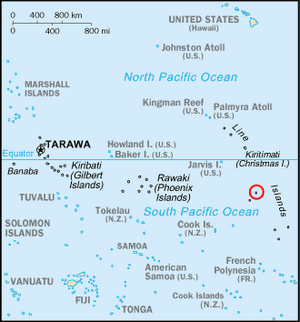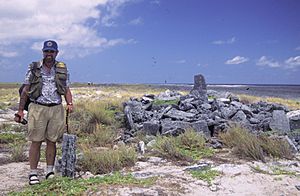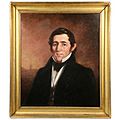Malden Island facts for kids
Malden Island is an island in the Pacific Ocean. Today, the island belongs to Kiribati. It is one of the Line Islands. In the 19th century the island used to be called Independence Island at times. The island is uninhabited today, it has been made into a nature reserve for breeding seabirds.
Contents
Geography
Malden Island is located 242 nautical miles (nmi) south of the equator, 150 nmi south of Honolulu, Hawaii. The coast of South America is more than 4,000 nautical miles (5,000 statute miles or 8,000 km) to the east.
The nearest land is uninhabited Starbuck Island, 110 nmi to the southwest. The closest inhabited place is Tongareva (Penrhyn Island),243 nmi to the southwest. The nearest airport is on Kiritimati (Christmas Island), 365 nmi to the northwest. There are other uninhabited islands nearby. They include Jarvis Island, 373 nmi to the northwest, Vostok Island, 385 nmi to the south-southeast, and Caroline (Millennium) Island, 460 nmi to the southeast.
The island has roughly the shape of an equilateral triangle, with 8 km (5 mi) on a side, aligned with the southwest side running northwest to southeast. The west and south corners are slightly truncated, shortening the north, east and southwest coasts to about 7 km (4 mi), and adding shorter west and south coasts about 1 to 2 km (1⁄2–1 mi) in length.
There is a large lagoon with many small islets in the east-central part of the island. The lagoon is completely sourrounded by land. It is connected to the sea by underground channels, and is quite salty. Most of the land area of the island lies to the south and west of the lagoon. The total area of the island is about 39.2 square kilometers.
The island is very low, no more than 10 metres (33 ft) above sea level at its highest point. The highest elevations are found along a rim that closely follows the coastline. The inside forms a depression that is only a few meters above sea level in the western part and is below sea level (filled by the lagoon) in the east central part. Because of this topography, the ocean cannot be seen from much of Malden's interior.
There is no standing fresh water on Malden Island, though a fresh water lens may exist.
A continuous heavy surf falls all along the coast, forming a narrow white to gray sandy beach. On the west coast, the white sandy beach is bigger. On the rest of the coast there is a strip of dark gray coral rubble, forming a ridge. This makes the beach itself smaller.
History
George Anson Byron, a British captain, discovered Malden Island on 30 July 1824. He named it after Charles Robert Malden who was the first to land on the island. At the time of its discovery, the island was uninhabited, but there were ruins. Archeologists discovered that the island was inhabited by between 100 and 200 Polynesians, a few centuries earlier.
The ancient stone structures are located around the beach ridges. Most of them are on the north and south sides. Overall, twenty-one sites are known. Three of them are larger than the others. They can be found on the northwest side of the island. The sites are either temples, houses or graves. The temple ruins are referred to as marae. Similar marae have also been found on other islands, such as Raivavae, one of the Austral Islands.
The inhabitants had also made wells, but later settlers found them to be dry, or too salty.
In 1828, guano was discovered on the island. In 1856, the United States wanted to get the Island, but Australian firms had already started to mine the guano deposits. Guano mining stopped about 1927. In 1956 and 1957, Great Britain tested H-bombs on the island. The tests were called Operation Grapple.
Images for kids
-
A pair of masked boobies (Sula dactylatra) calling on Malden Island
-
A mushroom cloud rising over Malden Island after the first British hydrogen bomb test in May 1957
-
Memorial tablet in Paisley remembering the people concerned in the tests
See also
 In Spanish: Isla Malden para niños
In Spanish: Isla Malden para niños










